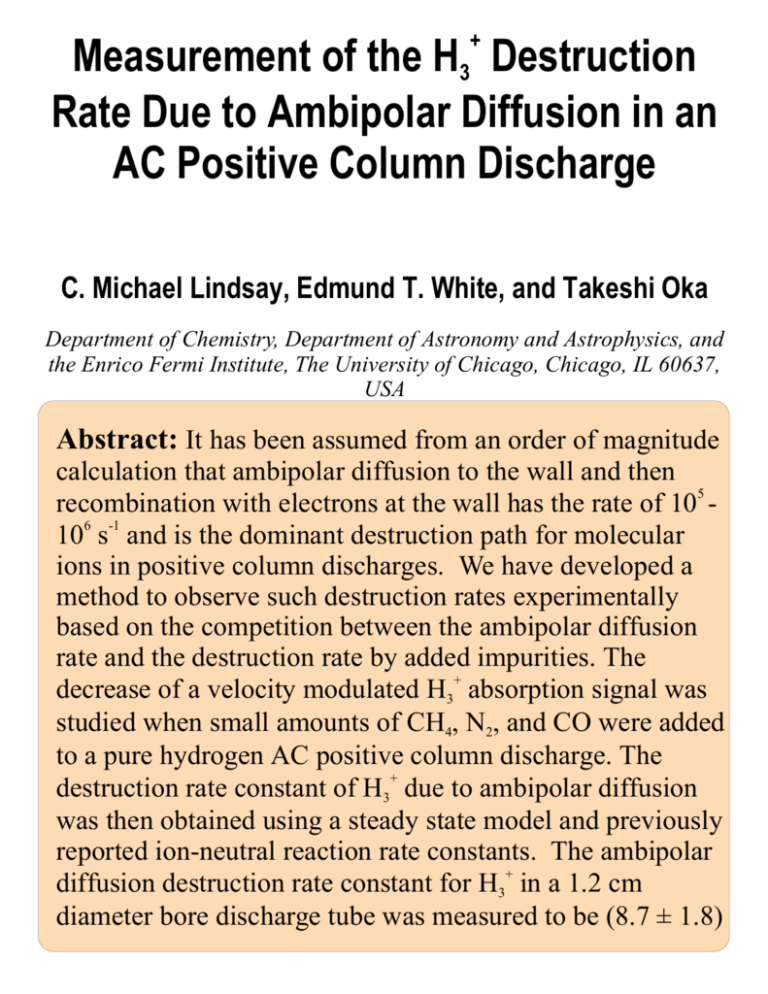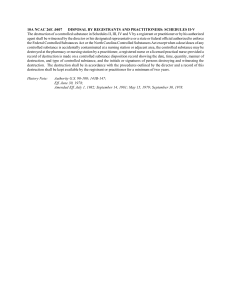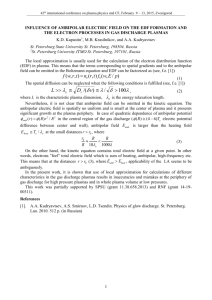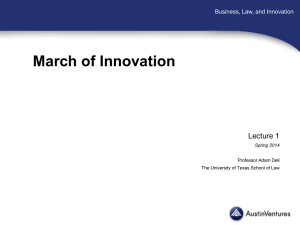Measurement of the H Destruction Rate Due to
advertisement

+ Measurement of the H3 Destruction Rate Due to Ambipolar Diffusion in an AC Positive Column Discharge C. Michael Lindsay, Edmund T. White, and Takeshi Oka Department of Chemistry, Department of Astronomy and Astrophysics, and the Enrico Fermi Institute, The University of Chicago, Chicago, IL 60637, USA Abstract: It has been assumed from an order of magnitude calculation that ambipolar diffusion to the wall and then recombination with electrons at the wall has the rate of 105 106 s-1 and is the dominant destruction path for molecular ions in positive column discharges. We have developed a method to observe such destruction rates experimentally based on the competition between the ambipolar diffusion rate and the destruction rate by added impurities. The decrease of a velocity modulated H3+ absorption signal was studied when small amounts of CH4, N2, and CO were added to a pure hydrogen AC positive column discharge. The + destruction rate constant of H3 due to ambipolar diffusion was then obtained using a steady state model and previously reported ion-neutral reaction rate constants. The ambipolar diffusion destruction rate constant for H3+ in a 1.2 cm diameter bore discharge tube was measured to be (8.7 ± 1.8) Introduction Hollow cathode and positive column glow discharges have been used for decades by spectroscopists to create molecular ions in the abundance necessary for direct absorption studies. AC positive columns are particularly important in this work because of the high degree of sensitivity and discrimination possible by the velocity modulation technique. [1] Kinetic models of these systems help predict discharge conditions (i.e. current, pressure, mixing ratios of starting gases) that should increase the steady state concentration of a species of interest. These models can also help identify the carrier of an absorption spectrum especially when it is unassignable, such as the recent case of the infrared spectrum of CH5+. [2] Kinetic models are constructed by considering the formation and destruction mechanisms. The production rate of molecular ions in the glow discharge depends on the charge density and ion-neutral reaction cross sections. Most ion-neutral reaction rate constants have been measured by various techniques, [3] and the charge density can be estimated from the electric current through the plasma. Ions are destroyed by either recombination with electrons or reaction with a neutral molecule. In hollow cathode discharges with a large diameter and low electron temperature the destruction rate is approximated by the dissociative recombination reaction rate in the bulk, which is easily obtained if the recombination rate constant is known. This is not, however, the quickest destruction process in the positive column where fast ambipolar diffusion occurs. Ambipolar Diffusion ! Molecules are primarily ionized in the center of the discharge tube and diffuse outward at the ambipolar drift velocity. ! Ambipolar motion can be described as an equilibration of the velocity of electrons and cations--the massive cations tend to be accelerated by the quick electrons and the latter, in turn, slowed. Models for this motion exist for simple systems and depend on the charge density, cation mobility, and electron temperature. ! Once cations reach the wall, they are destroyed very efficiently with electrons in the wall. This destruction rate can be very fast particularly when the tube diameter is small and the electron temperature is high as is generally the case in the positive column. Crude estimates of this process predict the average ion lifetime to be on the order of 10-5 ~ 10-6 sec. ! Due to the complexity of the partially ionized molecular plasma, a direct measurement of the ambipolar velocity has not been made. Consequently we are left only with an estimate of the destruction rate based upon an idealized model of a dissimilar system. We need some method to estimate the destruction rate more reliably. A direct approach... Study the primary destruction rate by supplying a secondary destruction machanism of the same order of magnitude Formation of H3+ - H2+ e k1 H2+ H2+ + H2 + 2e k2 - H3+ + H Destruction of H3+ + H3 + X H 3+ + e - k3 XH + + H 2 k4 slow in the positive column H2 + H, or H2 + H kAD + H3 + wall H + H + H, or H2 + H k Reaction Mean a (cm3s-1) k1 k2 k4 k3 H2 + eH2+ + H2 H3+ + eH3+ + CH4 H3+ + N2 H3+ + CO (0.4 - 8) × 10-11 b 2.04 × 10-9 10-7 - 10-11 c 2.33 × 10-9 1.86 × 10-9 2.02 × 10-9 a Uncertainty a (cm3s-1) ± 0.10 × 10-9 ± 0.26 × 10-9 ± 0.24 × 10-9 ± 0.28 × 10-9 Unless otherwise noted, values are averages of the rates published in Reference [3] with uncertainties reported at the 95% confidence interval. b Calculated from ionization cross section published in Reference [4]. Range is due to uncertainty in the electron temperature of our plasma (we assume Te ~ 2-3 eV). Since k1 drops out of the final expression, this large uncertainty does not affect the results. c The dissociative recombination rate constant has been part of a controversy in recent years, [5-8] taking on a wide range of values. Even if we assume the fastest rate, the destruction by dissociative recombination is still two orders of magnitude smaller than the estimated destruction rate of H3+ by ambipolar diffusion. d[H2+] + = k [e ][H ] k [H ] [H 2 ] = 0 1 2 2 2 dt 1 d[H3+] + + + k k X k = [H ][H ][ ][H ] [H 2 2 2 3 3 AD 3 ] = 0 dt 2 From 2 + k2[H2][H2 ] (k3[X] + kAD) 1 Rearrange and insert k1[H2][e-] (k3[X] + kAD) Ratio [H3+] with and without impurity = k 3 [X ] + 1 kAD For weak absorptions, the concentration is proportional to the velocity modulation absorption signal, I(H3+), therefore: k3 = k [X] + 1 AD Example of Raw Data 4 2 0 -2 -4 0 5 10 15 20 Impurity Pressure (mTorr) 25 This is an example of the raw H3+ signal plotted versus N2 pressure @ 200 mA. The dashed line is the function a b + x , added to emphasize the agreement with the expression derived in the experimental model. The first derivative lineshape is a result of the velocity modulation technique. Destruction Rate Plots 3.5 3.0 k4 /kAD = (2.13 ± 0.03) × 10 -15 cm3 2.5 2.0 1.5 1.0 0.0 0.2 0.4 0.6 0.8 1.0 Number Density of N2at 200 mA (in 1015 cm-3 ) 3.5 3.0 k4 /kAD = (2.30 ± 0.05) × 10 -15cm 3 2.5 2.0 1.5 1.0 0.0 0.2 0.4 0.6 0.8 1.0 Number Density of CH 4 at 150 mA (in 1015 cm -3 ) Here are two examples of the H3+ relative intensity versus number density of impurity. Each cluster of data contains 5 measurements. The slope of the least squares fit is equal to kk as shown in the experimental model. 3 AD Measured Destruction Rate Constants X Current kAD (×105 s-1) Uncertainty a (×105 s-1) CH4 150 10.1 ± 1.38 CH4 175 10.0 ± 1.38 CH4 200 9.96 ± 1.38 N2 150 5.96 ± 0.91 N2 175 6.06 ± 0.92 N2 200 6.74 ± 1.02 CO 150 10.0 ± 1.67 CO 175 9.48 ± 1.58 CO 200 9.48 ± 1.60 Mean: 8.66 ± 1.83 a Uncertainties reported at 95% confidence interval. Conclusion These results provide the first experimental evidence demonstrating that the initial order of magnitude estimate of the H3+ destruction due to ambipolar diffusion is correct and that this destruction mechanism is indeed very fast in the partially ionized positive column. Since the uncertainty in kAD presented here is not much worse than the error of most published ionneutral reaction rate constants, we can now model these plasma chemical systems without having to make any crude estimates. Furthermore, this technique is generally applicable in measuring destruction rates in any type of discharge cell as long as it is hydrogen dominated. References [1] C. S. Gudeman, M. H. Begemann, J. Pfaff, and R. J. Saykally, Phys. Rev. Lett. 50, 727 (1983). [2] E. T. White, J. Tang, and T. Oka, Science 284, 135 (1999). [3] V. G. Anicich and W. T. Huntress, Astophys. J. Suppl. 62, 553 (1986). [4] D. Rapp and P. Englander-Golden, J. Chem. Phys. 43, 1464 (1965). [5] M. T. Leu, M. A. Biondi and R. Johnsen, Phys Rev. A8, 413 (1973). [6] N. G. Adams, and D. Smith, IAU Symposium 120, Astochemistry, M. S. Vardya and S. P. Tarafdan, eds. (Reidel Publ. Co., Dordrecht 1987). [7] T. Amano, Ap. J 329, L121 (1988). [8] T. Oka, in Dissociative Recombination: Theory, Experiment and Application IV, edited by M. Larsson, J. B. A. Mitchell, and I. Schneider (World Scientific, Singapore, 2000).





